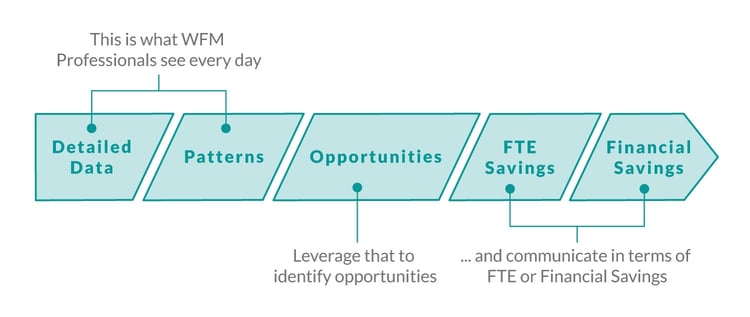Workforce management is the hub of some of the most vital data in an organization. How this data is leveraged can be the determine whether or not a business is profitable. In one of my director role in WFM, I joined a company that was actually very profitable but was running very inefficient operations. I shared my laundry list of operating “sins” we were committing in a meeting with my boss. His answer was “We have some of the best margins in the industry”. That was absolutely the case, but that was due to effective offshoring. So we were making money the same way our competitors were. But these savings weren’t scalable and it meant if our competition got their operating acts in order, they’d be able to cut costs, beat our prices, and drive us out of business.
The key to making a difference is to figure out what data in your operations can easily be translated into information for your operations to improve.
Some examples of this data are contact data (what types are coming in and when, productivity data (aht and shrinkage), and people data (where are people and what are they doing). This data can drive value for an organization, or it can remain dormant. In many organizations, this data doesn’t receive the level of attention and focus that it deserves. By taking an active approach, you can help your company become more profitable.
The first step in maximizing the value of this data is to recognize it’s there. This may sound obvious, but many teams are staffed only to do the administrative portions of their jobs - forecast, schedule, manage real-time. Taking the time to identify the valuable data and analyze it is a luxury. If you’re a WFM or operations leaders, take some time to identify the opportunities. If you are a WFM analyst or team leader, have a conversation with your leader about the opportunities. Unless you make the time to make the data into valuable information, it’s not likely to get traction.
So what is the best data to look at?
- Contact volumes by type
- Inbound
- Outbound
- Offline-generated work (e.g. the work has to be done, but isn’t from an ACD-tracked source
- Handle time
- Time engaged with a customer (talk time)
- Time working on customer work (after call work)
- Any AUX time that really belongs here
- People data
- What are the key AUX codes being used (and do they correlate to shrinkage)?
- Call efficiency data (e.g. AHTs of different groups taking different call types as you cross skill)
The most valuable data points vary by contact center type and industry. A great place to start is to see what your company or operations leaders are talking about. Is the focus on improving customer experience? Is it cutting costs? Or is it becoming the “employer of choice”. Likely it’s some combination of these 3, but likely one or two are more dominant. Understanding this dynamic will help you position your ideas, because it will help you speak their language and connect where it’s meaningful for them.
Now that you have some data, now what?
There are 2 things you can do with the data:
- Build correlations
- Understand how the various data points correlate with each other. A few examples:
- Correlate Net Promoter Score or Customer Satisfaction with your ASA or Service level. What’s the optimal ASA for your customer targets? You may be over-servicing
- Abandon Rate vs. Service level - While there will generally be an expected abandon rate at a given service level, you may find your customers abandon quickly or hang on.
- AHT across various groups - If you have multiple groups servicing the same call types (or are being cross-skilled), is there a point of diminishing returns?
- Call arrival patterns vs. intraday service level - Do you tend to over or under service consistently at certain parts of the day?
- As you can see, you can take many different types of data and look at, and many different types of analyses you can do with it.
- Understand how the various data points correlate with each other. A few examples:
- Identify trends in the data
- Is a particular metric going up or down over time?
- Do you notice any clear drivers?
- Has your center accepted something as “normal”, just because it’s always been a certain way (a good example of this is low service levels on Monday).
Once you have the insights and trends, the next step is to figure out how to present your ideas to leadership.

Start with a problem statement that resonates with leadership. Look at it through their lens. What problem are you actually solving for? What facts and conclusions do you want to present?
Tips:
- Always talk in terms of FTE or dollars
- Be balanced in your recommendation.
- What are the tradeoffs or negatives?
- Keep in mind people expect WFM to only focus on efficiency.
- Socialize your ideas with someone who can be an advocate and give you feedback
- Be patient. Often it takes time to get movement, but it will pay off in the end!
Here’s an example:
If you believe your data shows you need to adjust your operating hours, and you know the leadership priority is customer service, a good problem statement could be: “Our customers aren’t being serviced effectively when they want to be serviced”. This illustrates that you’re going to develop a solution that’s customer-focused, and based on the fact that volumes are coming in outside of your operating hours that you can better service if you expanded your hours to capture that work live.
You may then run a new set of schedules that shows how you would align staff to the distribution pattern of the extended hours of operations. Lastly, you’d show how your scheduling efficiency would mathematically be better, and ideally that you’d achieve the same or better service level with the staff. Translating the improved schedule efficiency into an FTE savings makes for an easy conversion to financial savings, by just applying the annual salary per FTE. You would present your problem statement, recommended solution, and financial savings in one setting with your leadership.
Try these techniques and let us know how they work for you!
Did you find the article interesting and would like to share it with your colleagues? Download the article as a PDF.





